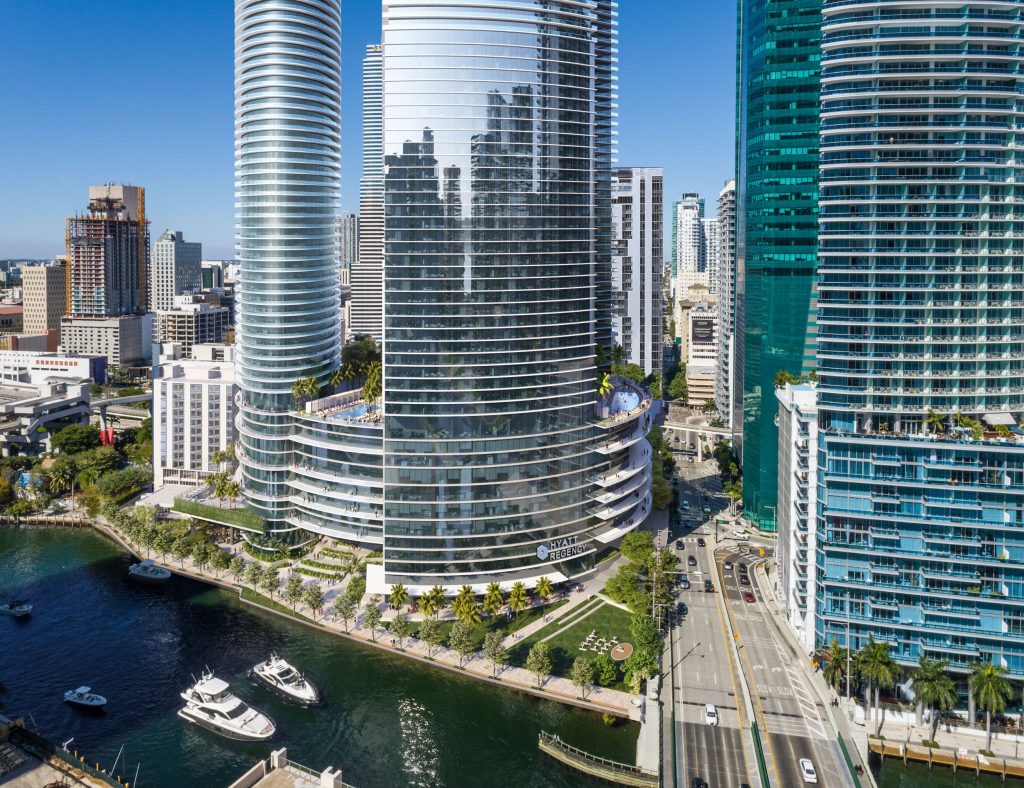The news that Miami will host the 2026 FIFA World Cup puts a giant exclamation point on a three-year run that has seen South Florida host a Super Bowl, a Formula One Grand Prix, and an international tennis tournament. With the World Cup on the way, Miami will become the only city in the world to host F1, the NFL, NBA, NHL, MLS, and soon, FIFA soccer.
“All these national and global sports have not only a direct economic impact on hotels and the everyday person who’s working in our city, but also a branding impact that is incalculable,” said City of Miami Mayor Francis Suarez. “People are going to experience Miami, they’re going to see images of Miami, and the tail of that economic development is incalculable.”

Miami’s rise to the pinnacle of professional sports coincides with its emergence as a vital hub for commerce and investment coming from across the U.S. and around the world. From the arrival of elite hotels and international restaurants, to multinational corporations opening headquarters and recruiting talent, Miami is well suited to welcome global brands with open arms.
Just this week, the Wall Street Journal broke the news that Citadel Securities, a Chicago-based hedge fund with more than $50 billion in assets and roughly 1,000 employees, will relocate its headquarters to Miami over the coming years. Citadel’s planned move is the latest in a series of high-profile relocations that have seen new-to-market firms make the move to Miami in pursuit of cost savings, a diverse talent pool, and improved quality of life.
Miami’s road to international relevance has been years in the making, according to Tadd Schwartz, President of Schwartz Media Strategies, an integrated communications firm that has been Fueling Florida and Moving Miami since its founding in 2005. In that span, Schwartz and his team have led public relations, digital media, and marketing campaigns on behalf of blue-chip clients across the sectors driving Miami and South Florida.
“It wasn’t long ago that Miami was seen as a second-tier city awash with empty condos and vacant offices. We were the posterchild of a community that grew too fast, developed too much, and couldn’t sustain its trajectory. Over the past seventeen years, our firm has helped change the narrative through our work on behalf of Miami’s most beloved destinations, its top law, real estate and financial firms, and its most important cultural and entertainment venues.”
As Miami rides a wave of prosperity and adapts to a fast-changing population and business landscape, Schwartz believes it’s critical that the city address its shortcomings with an eye toward smart, sustainable growth.
“For all the strides we’ve made, Miami is still facing its share of challenges. From promoting affordability and mobility, to protecting against climate risks, managing rapid growth is never easy. As more people embrace living, working, and raising a family in South Florida, we have an opportunity to harness the power of new ideas that will shape the future of our community. Landing the World Cup, Michelin Guide, and Formula One in the span of two months is significant, but given the rate of change we’re experiencing, I’m even more excited about what’s in store over the next few years.”
Here’s a look at five trends that will reshape Miami leading up to the 2026 FIFA World Cup:
- Business and Wealth Migration Intensifies: Conventional wisdom held that the flood of inbound residents gravitating toward Miami would reverse course once the pandemic cooled and cities to the north relaxed safety precautions. Truth be told, the trend is strengthening. More than 21,000 New Yorkers applied for Florida driver’s licenses during the first four months of 2022 – a 12 percent spike over 2021 activity.
At the same time, the flow of businesses to Miami is picking up, with 32 new-to-market office leases signed so far this year, nearly matching the 38 deals inked by inbound firms during the entirety of 2021. Numbers like these are putting to rest any speculation that the wave of companies moving and expanding to Miami is waning, and there’s every reason to believe the trend will grow even stronger as South Florida’s business infrastructure improves and its talent pool deepens.
- Miami’s Skyline Rises Higher and Higher: As a coastal community bounded by the Atlantic Ocean to the east and the Everglades to the west, Miami only has one way to grow – up. Given its land constraints, it should come as no surprise that a new generation of developers is looking skyward in planning for the city’s future. Expect Miami’s skyline to look quite different by the time soccer fans descend on South Florida for World Cup action.
In the past month alone, two projects featuring so-called ‘super-tall’ buildings exceeding 1,000 feet in height have been proposed in Miami’s urban core: a multifamily tower to be developed by Hyatt and Gencom at the riverfront site now occupied by the Hyatt Regency in Downtown Miami, and a Class-A office tower at Brickell City Centre to be built by Related and Swire. If timelines unfold as planned, both towers will be well underway by kick-off in 2026.

- Dining Out Takes on New Meaning: For the first time ever, the esteemed Michelin Guide brought its acclaimed star rating system to Miami and Florida in 2022. All told, 11 Miami restaurants scored stars in the inaugural guide, providing an instant boost to some of the city’s most beloved eateries. It’s anyone’s guess how many more hot spots will lay claim to stars by 2026, but one thing is certain: the arrival of Michelin has elevated Miami’s appeal as a dining destination and that will attract even more star-worthy chefs.
- Getting Around Gets Easier: The arrival of more residents, businesses and tourists between now and 2026 is sure to create traffic headaches, but relief is on the way. Over the next four years, a series of large-scale infrastructure projects will relieve congestion on South Florida streets and make it easier to get around town, whether its by car, foot, bike or train.
The most significant addition for World Cup fans will be the expansion of the Brightline rail system. By 2026, the Brightline will add a long-awaited extension to Orlando along with stops in Boca Raton and Aventura. In the heart of Downtown Miami, construction of the signature I-395 bridge will bring a breath of fresh air for motorists traveling between Miami Beach and Miami International Airport. Nearby, the continuation of The Underline linear park and urban trail will offer pedestrians and cyclists 10 miles of paths that make it possible to navigate the city without getting behind the wheel.
- Haute Hotels Beckon Global Travelers: Driven by a surge of domestic and international travel, it seems Miami’s tourism sector is setting new records with each passing month. Earlier this year, Miami International Airport was ranked as the busiest international airport in the U.S. – with passenger volume up 92% year over year through the first four months of 2022. Hotels, likewise, are thriving, with the average daily room rate in Miami for the first five months of 2022 up 56% over 2019 levels.
The good news for travelers is that more lodging options are on the way, and Miami’s newest crop of hotels will be decidedly upscale. Over the coming years, Miami is set to welcome outposts of three new hotel flags that will set a new standard in a city that knows a thing or two about luxury: a new Aman resort in Miami Beach, the first-ever Bvlgari-branded hotel in the U.S., and a new Waldorf Astoria tower set to rise in Downtown Miami.








 See More Blogs
See More Blogs
Comments